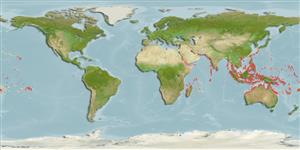Common names from other countries
Issue
Genetic data indicate that Ellochelon vaigiensis is a complex of species (Ref. 114224). At least 3 species have been recognized (Refs. 114224, 123263, work in progress) and are being described, with probable parapatric distributions (Durand, pers. comm., Nov. 2020).
Environment: milieu / climate zone / depth range / distribution range
Sinh thái học
Biển; Nước ngọt; Thuộc về nước lợ Cùng sống ở rạn san hô; Di cư sông biển (để đẻ trứng) (Ref. 46888); Mức độ sâu 0 - 5 m (Ref. 89972). Tropical; 32°N - 24°S, 30°E - 141°W
Indo-Pacific: Red Sea and from East Africa to the Tuamoto Islands, north to southern Japan, south to southern Great Barrier Reef and New Caledonia (Ref. 9812).
Bộ gần gũi / Khối lượng (Trọng lượng) / Age
Maturity: Lm ? range ? - ? cm
Max length : 63.0 cm TL con đực/không giới tính; (Ref. 9710); common length : 35.0 cm TL con đực/không giới tính; (Ref. 9812)
Các tia vây lưng cứng (tổng cộng) : 5; Các vây lưng mềm (tổng cộng) : 8 - 10; Tia cứng vây hậu môn: 3; Tia mềm vây hậu môn: 7 - 9. Diagnosis: This species is distinguished by the following characters: robust body; usually with 16 pectoral-fin rays; 25-29 longitudinal scales; 16 circumpeduncular scales; weakly ctenoid scales; adults with longer snout than eye diameter, shorter in juvenile; poorly developed adipose eyelid, forming narrow rim around eye; weak notch on anteroventral edge of preorbital; truncate caudal fin; colour olive-brown dorsally, flanks and belly silvery to whitish; about 6 brownish stripes on flank formed by longitudinal marks on scales; fins yellowish white with dusky margins except caudal fin yellow and pectoral black dorsally and yellow ventrally (completely black in young); no axillary scale visible in the pectoral fins (Ref. 9812, 90102).
Found in lagoons, reef flats, estuaries, and coastal creeks, in shallow coastal areas and protected sandy shores (Ref. 40488). Usually within tidal influence, but may enter fresh water, ascending 10 km into rivers (Ref. 40488). Forms large schools, frequently in mangrove areas (Ref. 2334). Juveniles may be found in rice fields and mangroves and may be used as bait fish (Ref. 9812). Oviparous, eggs are pelagic and non-adhesive (Ref. 205). Feeds on phytoplankton, small algae and detritus organisms (Ref. 89972). Caught in cast nets, stake
nets, beach seines, and gill nets; marketed fresh and salted; boiled (Thailand), canned or frozen (Australia). Roe also marketed salted and juveniles used as bait fish (Ref. 9812)..
Life cycle and mating behavior
Maturities | Sự tái sinh sản | Spawnings | Egg(s) | Fecundities | Ấu trùng
Myers, R.F., 1991. Micronesian reef fishes. Second Ed. Coral Graphics, Barrigada, Guam. 298 p. (Ref. 1602)
IUCN Red List Status (Ref. 130435)
CITES (Ref. 128078)
Not Evaluated
Threat to humans
Reports of ciguatera poisoning (Ref. 130160)
Human uses
Các nghề cá: Tính thương mại; Nuôi trồng thủy sản: Tính thương mại; Bể nuôi cá: Tính thương mại; mồi: occasionally
Các công cụ
Special reports
Download XML
Các nguồn internet
Estimates based on models
